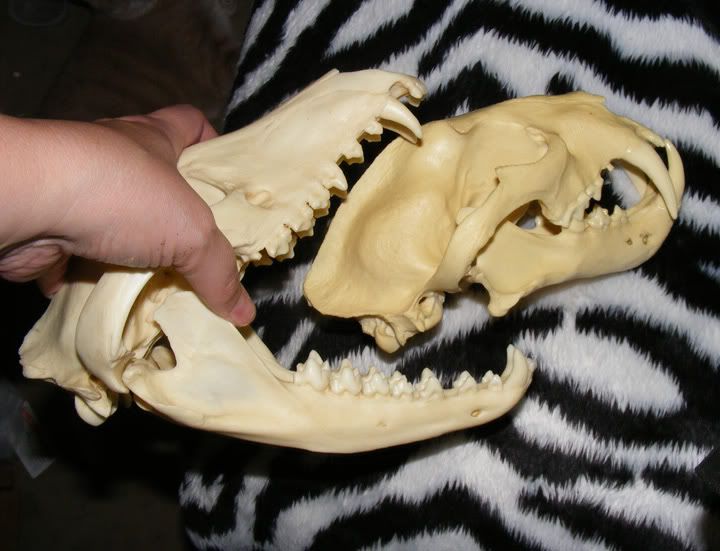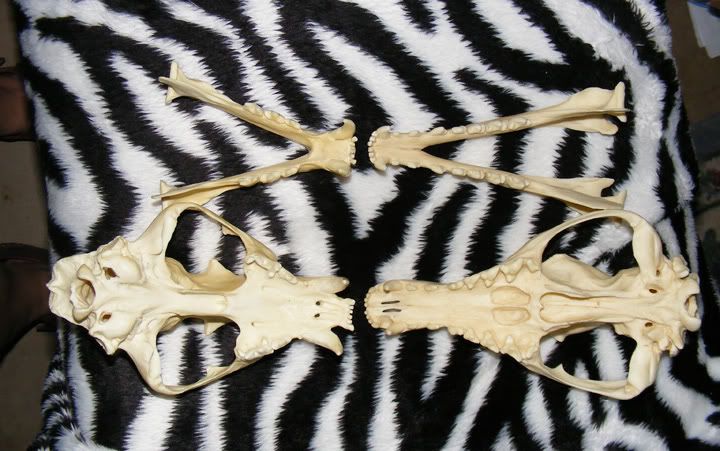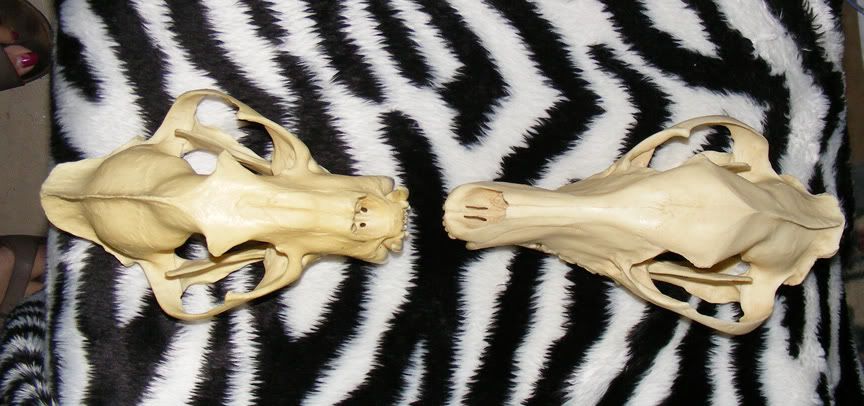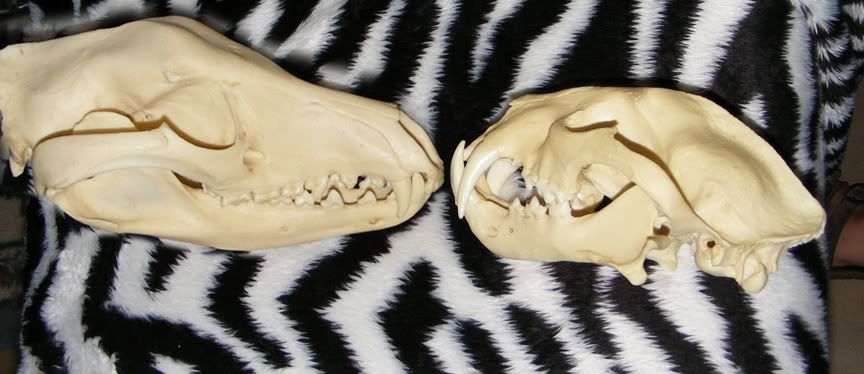Вы не зашли.
Объявление
"Давайте только проявлять больше внимания, терпимости и уважения к чужому мнению — вот и всё." — Gennadius.
— О размещении изображений на форуме, О рекламе на форуме
#276 04 April 2012 14:38:29
- Crazy Zoologist
- Гость
Re: Сумчатый волк, или тилацин (Thylacinus cynocephalus)
Chasing the Thylacine
independent - On a bright summer morning in the back end of Tasmania's north-west, I wandered into an office of Forestry Tasmania for advice about a forest dirt road. The sketch map the official offered was expected; not so his story. On that same track a decade or so ago, he had seen a creature that was not supposed to exist. And not just him; loggers and surveyors, an old-timer shacked up in the bush, all had glimpsed the animal before it slipped away into one of the most ancient rainforests on Earth.
Foresters are generally a practical bunch who measure life by certainties such as sawlogs and stray limbs lost to heavy machinery. When they swear to a sighting, you begin to wonder if there's truth after all to the Tasmanian tiger.
There are really only two things you need to know about the world's largest carnivorous marsupial. The first is that it looks nothing like its namesake except for the sandy orange coat and stripes that extend down to a stiff tail. The tiger – or thylacine as it is usually known because of its scientific name, Thylacinus cynocephalus, which means "pouched dog with a wolf's head" – is an evolutionary concept-creature that bolts the back half of a kangaroo on to a rangy dog the size of an Alsatian. The second is that it has been extinct for seven decades. Or it has unless you ask around. Then it turns out they're everywhere.
The first one I saw was in Hobart, the state capital. In the Tasmanian Museum and Art Gallery, a small crowd gathered around footage of a restless creature in the city zoo with a slender snout that opened to a snake's gape and a stiff gait that another believer later compared to a dairy cow. When "Benjamin" became history one chilly September night in 1936, he is thought to have taken the species with him.
Start to look, however, and a tiger will be there staring back at you. It gazed coolly from the label on my bottle of Cascade beer. It slinked into grass on the number plate of every car in front. And tigers rampant flanked the heraldic crest on state buildings – who needs unicorns when you have a home-grown fabulous beast?
No wonder tiger-hunters become obsessed. To the newcomer, Tasmania is the surprise of Australia. It is an island of hidden secrets in a nation of infinite space; a place where real-life devils utter banshee wails and moss-bearded giants stand silently in forests that predate mankind. In this Middle Earth of lost myths, a legendary tiger is just part of the scenery, and there's a lot of that to cover in a state that's one-quarter wilderness.
Many otherwise eminent people have suffered ridicule and nights cooped up in a chicken shed with a camera in their pursuit. The government's Parks and Wildlife Service mounted its own two-year hunt in 1984 before it pronounced the species extinct and devoted its energies to finding feral foxes instead. That only upped the ante.
"Parks don't want to say anything publicly to attract attention," Ned Terry confided. We were drinking coffee in Deloraine in the state's north, where farming villages were scattered over my map like seed and the landscapes are so vivid that the first pioneers christened their settlements Eden, Paradise and Promised Land. Hard to believe that the Alpine wilderness of Cradle Mountain lay an hour's drive south. "The bush was full of tourists after a national park fellow reported a thylacine on the central east coast a few years ago. But those blokes got a lot of cameras out there to look for foxes. I wouldn't be surprised if there's some skulduggery going on."
In this zoological X-Files, the 80-year-old bushman plays Mulder. Every couple of months he listens patiently to an excited witness, asks a few questions to weed out the fakers, then follows up whoever is left. His latest credible lead in half a lifetime's tiger-chasing came from Lake Peddar in the south-west wilderness.
"Fellow camped out there says he heard one for three weekends in a row; that yapping noise they make when hunting. Says it ran so close he could smell it."
Many witnesses mention the smell – a sharp, hot, animal stink that electrifies the air. "Smelled it myself once," Terry said. "Makes the hairs on your neck stand on end, I can tell you."
The truth is out there, somewhere. Probably (I dragged out of Terry) in the remote northern corners of the state. So, in the late afternoon I rolled east over swells of grass bound for Scottsdale. Every so often a timber farmhouse heaved aloft on a crest then vanished into the rear-view mirror. Beyond lay the high country of the north-east.
Around seven thylacine sightings a year, more than anywhere else in Tasmania, were made up there in the half-century after Hobart Zoo lost its star attraction. A few tiger-hunters still came to shoot blurry images, stalking the edge of old-growth rainforest that had barely changed since Tasmania ripped away from the global supercontinent of Gondwanaland.
In the pub I met a farmer who yarned about a wolfish head that had poked through the bracken fern. "When he comes out he sits up like a kangaroo, then starts sniffing the air like one. I thought: 'What the hell's that?'" A stray dog, perhaps, I suggested. "No dogs up there," he bristled.
It turned out the area was swarming with rumours. Craig Williams, Tasmania's premier wildlife guide and a fourth-generation bushman, kept up a rumble of anecdote and oath as we skirted the forest, stopping occasionally to practise an arcane element of bushcraft or stare after a furry backside that disappeared into the scrub. He indicated a farmstead as we swerved around one corner. "You know the last thylacine died in 1936? An old bloke shot one there in 1946. Said it was killing his chooks [chickens]."
Later, after a meal that belonged to a Sydney restaurant rather than a remote mountain shack, Craig told tiger tales around the campfire. There was the thylacine witnessed by four people on a logging road just over that ridge, and the waxy scat found late last year by the manager of a wilderness lodge. Or there was his mate whose car had broken down up here one night: "He said he heard these high-pitched yaps following him as he walked."
Apparently Craig's grandfather and great-grandfather used to trap thylacine on the mountain behind us. I tried and failed to reconcile the mysterious thylacine with the plantation forest that now striated its flanks. Could it really survive here?
As the sky deepened to a velvety black, Craig strobed the treeline with a torch. There were secrets as well as possum eyes in the dark spaces between eucalyptus trunks. Suddenly, at the edge of our clearing, something twitched. A stoat-like animal froze in the torch's beam then skittered into the bush – a spotted-tailed quoll.
"Amazing killing machines; the ultimate predators," Craig said with admiration. "They're only a few kilos, but they can pull down a wallaby." With jaws that opened to 90 degrees and overlapping teeth, it was a distant relation of the thylacine colloquially known as a tiger quoll. "Been quite a few tiger sightings by quite a few people made around here."
I'd lost my bearings way back on the unmarked dirt roads. "Good," said Craig. "I don't want loads of people running around with traps and cameras. If the tiger's up here, let him be. That's what I reckon." Another Tasmanian secret was safe.
Далее тут http://naturalplane.blogspot.com/2010/0 … acine.html
Еще про тилацина (помимо всего прочего) есть интересная инфа в фильме "Дикий Юг", серия "Тасмания. Последнее убежище". Выкладывал в соотвествующем разделе.
#277 04 May 2012 22:26:01
- Crazy Zoologist
- Гость
Re: Сумчатый волк, или тилацин (Thylacinus cynocephalus)
Черепа сумчатого волка, слева и в центре и череп динго, справа.
#278 10 May 2012 06:02:16
- Miracinonyx
- Любитель животных

- Зарегистрирован: 05 December 2006
- Сообщений: 19226
Re: Сумчатый волк, или тилацин (Thylacinus cynocephalus)
Если представить 5 таких черепов динго вокруг одного тилацинового - вполне понятно, почему он вымер в Австралии...
Вообще интереснее было бы сравнить его не с динго или волком, а с койотом или шакалом. Это сопоставление справедливее...
Неактивен
#279 11 May 2012 15:20:22
- Crazy Zoologist
- Гость
Re: Сумчатый волк, или тилацин (Thylacinus cynocephalus)
Сумчатый волк и дымчатый леопард:






#280 11 May 2012 18:08:05
- Crazy Zoologist
- Гость
Re: Сумчатый волк, или тилацин (Thylacinus cynocephalus)
Смотря на какой фотке:-). Череп сумковолка длиннее.
#281 11 May 2012 18:54:45
- Crazy Zoologist
- Гость
Re: Сумчатый волк, или тилацин (Thylacinus cynocephalus)
Так я же написал - черепа сумковолка и дымчатого леопарда. Тот что покороче и с более длинными клыками - дымчатый леопард.
#282 11 May 2012 19:27:26
- Crazy Zoologist
- Гость
Re: Сумчатый волк, или тилацин (Thylacinus cynocephalus)





Нагрузки на череп при укусе.
Thylacine's weak jaws linked to its extinction
By Bob Beale
September 1, 2011
Australia's iconic thylacine – or Tasmanian tiger – was hunted to death for allegedly killing sheep, but in fact it had such weak jaws that its prey was probably as small as a possum, a new study has found.
"Our research has shown that its rather feeble jaw restricted it to catching smaller, more agile prey," says ecologist and doctoral student Marie Attard, of the UNSW Computational Biomechanics Research Group, the lead author of a new paper in the Journal of Zoology.
"That's an unusual trait for a large predator like that, considering its substantial 30 kg body mass and carnivorous diet. As for its supposed ability to take prey as large as sheep, our findings suggest that its reputation was at best overblown.
"While there is still much debate about its diet and feeding behaviour, this new insight suggests that its inability to kill large prey may have hastened it on the road to extinction."
Thylacines were top predators that once ranged across Australia and New Guinea but were found only in Tasmania by the time of European settlement. The resulting loss of habitat and prey – and a bounty paid to hunters to kill them - have been blamed for the demise of this carnivorous marsupial. Despite its obvious decline, it did not receive official protection from the Tasmanian Government until two months before the last known individual died 75 years ago at Hobart Zoo, on 7 September, 1936.
Using advanced computer modelling techniques, the UNSW research team was able to simulate various predatory behaviours - biting, tearing and pulling - to predict patterns of stress in the skull of a thylacine and those of the two largest remaining marsupial carnivores, the Tasmanian devil and the spotted-tailed quoll.
The thylacine's skull was highly stressed compared to those of its close living relatives in response to simulations of struggling prey and bites using their jaw muscles.
“By comparing the skull performance of the extinct thylacine with those of closely related, living species we can predict the likely body size of its prey," says the director of the Computational Biomechanics Research Group, Dr Stephen Wroe.
"We can be pretty sure that thylacines were competing with other marsupial carnivores to prey on smaller mammals, such as bandicoots, wallabies and possums.
“Especially among large predators, the more specialised a species becomes the more vulnerable is it to extinction. Just a small disturbance to the ecosystem – such as those resulting from the way European settlers altered the land - may have been enough to tip this delicately poised species over the edge."
Media contacts:
Marie Attard – marie.attard@unsw.edu.au
Stephen Wroe – s.wroe@unsw.edu.au
UNSW Faculty of Science media liaison – Bob Beale, 0411 705 435 bbeale@unsw.edu.au
#283 11 May 2012 19:31:27
- Crazy Zoologist
- Гость
Re: Сумчатый волк, или тилацин (Thylacinus cynocephalus)

#284 11 May 2012 20:07:47
- Crazy Zoologist
- Гость
Re: Сумчатый волк, или тилацин (Thylacinus cynocephalus)
Скорее всего да.
#285 13 May 2012 08:22:01
- Левша
- Любитель животных

- Зарегистрирован: 19 December 2010
- Сообщений: 709
Re: Сумчатый волк, или тилацин (Thylacinus cynocephalus)
Could Direct Killing by Larger Dingoes Have Caused the Extinction of the Thylacine from Mainland Australia?
http://www.plosone.org/article/info%3Ad … 62B1AB0237
Загрузка рисунков http://savepic.net/index.php
Неактивен
#286 13 May 2012 18:40:54
- Homotherium latidens
- Любитель животных
- Зарегистрирован: 11 February 2011
- Сообщений: 260
Re: Сумчатый волк, или тилацин (Thylacinus cynocephalus)
Ровно 82 года назад был убит последний дикий тилацин. ![]()
Неактивен
#287 30 May 2012 09:21:30
- Crazy Zoologist
- Гость
Re: Сумчатый волк, или тилацин (Thylacinus cynocephalus)
Rilla Martin’s 1964 photo of the ‘Ozenkadnook tiger’
Photos purported to show ‘mystery animals’ are always great fun. One of the most perplexing and curious of the lot was taken on a box Brownie camera near Goroke, western Victoria, Australia, in 1964. I’m referring, of course, to Rilla Martin’s photo of a strange, striped, running mammal.
This photo has generally become known as ‘the Ozenkadnook tiger photo’; in fact, the term ‘Ozenkadnook tiger’ was and is used for a supposed mystery beast (suspected by witnesses and locals to be a mainland Thylacine Thylacinus cynocephalus) seen since the 1880s across southwestern Victoria and southeastern South Australia (Healy & Cropper 1994). The specific photo is, therefore, better known as ‘the Rilla Martin photo’.
Martin reported that, while on holiday one day in 1964, she was driving along between Goroke and Apsley. With time to spare, she chose to drive along the dirt track near Ozenkadnook. She’d been photographing relatives while at Goroke (where her cousin lived) and had the camera next to her, on the front seat. In the woods close to the road, she caught sight of an unusual animal, standing at the edge of the scrub. She stopped the car and snapped one photo, just as the animal began to run away [a close-up of its head is shown below].
Martin later returned home to Melbourne, and there then seem to be two versions of what happened next. Some sources state that she mailed the photo to her relatives (saying in a letter “Here is the photograph of the animal that I told you about”), who then took it to the local newspaper office (Chapple 2000). Others imply that she handed the photo herself to The Wimmera Mail-Times (Williams & Lang 2010). It then appeared in the Syndney Morning Herald and became a national sensation. Unable to identify the animal, “wildlife experts were quick to denounce it as a fraud” (Williams & Lang 2010, p. 202). A claim from 1969 that her cousin developed the film for her, and inserted a photo he had taken of a “dummy tiger”, is inconsistent with both stories and seems to be an invention.
Martin’s photo has been much reproduced and is highly familiar to people who know the cryptozoological literature: it shows what looks like a large, quadrupedal predator with a long tail, deep chest, tall shoulders, and a rather deep head. The photo really isn’t that bad, but foliage that overlaps the head makes it difficult to work out what the head’s shape really was. Incidentally, the original photograph has been lost by the offices of The Wimmera Mail-Times, so all the versions you see here and elsewhere are scans of copies published by newspapers (and I’ve no idea where the negatives are).
What looks like an upper outline to the snout and forehead is, I currently think, actually an illusion resulting from fortuitously arranged twigs and leaves. There might be an ear visible at top right, but again I think this might be an illusion. An imaginative reconstruction of the animal is shown above in a cartoon I produced many years ago (Martin’s beast is shown alongside a few other Australian creatures of cryptozoological interest).
Martin reported that the animal had a pig-like snout and she compared the creature with a labrador in size. Its ‘striping’ is perhaps its most vexing feature: it really looks like the animal has pale striping across its shoulders and the back of its neck, with a darker ground colour surrounding these stripes and much of the rest of the forequarters. The hindquarters appear slender compared to the deep chest and the tail looks long and slim. The hindquarters are also very light in tone, almost certainly as a result of bright sunlight falling on this part of the animal. Indeed, it’s very hard to know where light and shadow end and where pigmentation begin on the animal, and Martin herself said that she didn’t much notice the stripes when taking the photograph. This might mean that the ‘stripes’ are dappling formed by sunlight. It’s not really possible to know.
One minor point worth noting is that, like so many ‘famous’, oft-reproduced photos, the version you see in many books is cropped and the original was somewhat larger [as an example, the adjacent cropped version is from Michell & Rickard (1982). Compare it with the uncropped version used above]. Uncropped versions show more forest litter in the foreground, and more trees in the background.
So… what is it? I don’t know, and I’d welcome your thoughts. It doesn’t look to me like a big cat or a domestic or feral dog: the shape is just wrong. And nothing else matches either: it’s clearly not a kangaroo, horse, or anything else that might be expected to be wandering around the scrub in Victoria. A popular suggestion in the cryptozoological literature has been that the creature was perhaps either a Thylacine or a thylacoleonid (= marsupial lion). Thylacines officially became extinct on the Australian mainland about 3000 years ago (and the last verified individual – Benjamin, of Hobart Zoo – died of neglect in 1936), but it’s well known that many people claim to have seen them on the mainland in recent years. Of course, one could embark at this point on a lengthy discussion of Thylacine survival… I’ll leave that for another time.
Does the animal in Martin’s photo look like a Thylacine anyway? Actually, its shape and the positions of its legs are vaguely Thylacine-like: the high shoulders, the apparently long, slim tail, and the stiff look to the forelimbs all remind me (and others: Healy & Cropper 1994) of a running Thylacine. But things aren’t quite right: the shoulders look too high for a Thylacine and the proportions are off. And what the hell is going on with the striping? If the head really is deep and blunt-snouted, this also counts against a Thylacine identity [the adjacent staged Thylacine photo - by H. Burrell, taken in 1921 - is one of several argued by Freeman (2005) to be of a posed taxiderm specimen. I'm not sure I agree that the specimen was a stuffed one, but there's no doubt that the photos were staged].
The thylacoleonid idea (mooted by those who have proposed that the big, striped predators seen in the Australian bush might, just might, be living marsupial lions) is even more fanciful than the Thylacine one.
Could it have been a hoax? The object in the photo looks like a real, three-dimensional animal with muscles. An attempt by the ABC TV company to put a hand-painted wooden cut-out near the location of the sighting and photograph it reportedly resulted in photos that look like those of a cut-out (Healy & Cropper 1994). John Martin, Rilla’s brother, stated as recently as 1999 that the photo was no hoax and, responding to suggestions that photo manipulation of some sort might have been involved, stated that “we country kids hardly knew how to take a photo, let alon[e] fiddle with it” (Williams & Lang 2010, p. 202). I don’t think it’s a hoax: I think it’s a photo of a real animal. And that’s basically all I have to say. I long to know what the creature is, but I can’t work it out. Let me know what you think.
The story of Rilla Martin’s 1964 photo has been told many times in the mystery animal literature. This article was mostly inspired by its discussion in Michael Williams and Rebecca Lang’s new book Australian Big Cats: An Unnatural History of Panthers [shown in adjacent image], which I’m currently reading and will be reviewing here at some stage.
UPDATE (added 20th August 2010): while looking at the photo again today, I noticed something I haven’t seen before (but possibly alluded to in comment # 6 below): beneath the left hindlimb is what looks like a curved supporting structure, clearly demarcated from the surroundings and with alternating dark and light bands. A close-up of the relevant part of the photo, and a very schematic attempt to depict it, is shown here. Now that I’ve noticed this, it’s difficult not to interpret it as an artificial supporting structure.
#288 30 May 2012 09:39:13
- Чайка
- Любознательный

- Зарегистрирован: 03 April 2012
- Сообщений: 152
Re: Сумчатый волк, или тилацин (Thylacinus cynocephalus)
Да, человек способен истребить все. Очень жалко.
Есть два способа прожить жизнь: или так, будто чудес не бывает, или так, будто вся жизнь — чудо. Альберт Эйнштейн
Лучший способ изучить что-либо - это открыть самому. (Дьёрдь Пойя)
Неактивен
#289 30 May 2012 16:04:21
- Сифака
- Любитель зоологии

- Откуда: царство гоблинов
- Зарегистрирован: 15 March 2008
- Сообщений: 1119
Re: Сумчатый волк, или тилацин (Thylacinus cynocephalus)
Чайка, не надо так безнадежно!
http://www.youtube.com/watch?v=88cXvs5Rmnk
если это не журналисткий гон, а это именно журналисткий гон (хотя бы потому, что серьезного исследования не было - опросили свидетелей, одного ученого, смочили чьи-то какашки, для полноты географии посветились там-сям, поставили камеру на сутки(!) ой, это ж надо не попал в кадр, как будто речь идет про обычных, бродящих от скуки бесцельно по лесу, животных), то даже и в этом случае, что какое-то количество тилацинов осталось доживать существует. Был фильм на эту тему, созданый телеканалом посолиднее, чем ЗОО-ТВ, вроде нэшнл джиографик, там конкретно показали дядечку на тасмании, который сказал "Они есть, я их видел и знаю, где найти, но хрен покажу всем так как придут ученые и если не они добьют, так это сделают туристы или охотники-экстремалы". Может он из ряда болтунов, может и журналисты с джиографик текст ему подготовили, а может и правда - ведь в продажном мире не так много людей, которые не продадут свою душу и за тонны золота.
Одна наша форумчанка живет на Тасмании, я интересовался как много диких мест на Тасмании, в которых люди годами не бывают. Говорит, что есть глухие места на маленькой Тасмании...
"Детальная реконструкция для древнейших представителей позвоночных, включающая и реконструкцию более поверхностных мышц, как правило,
граничит с вымыслом."
В.Ю. Решетов
Неактивен
#290 30 May 2012 17:43:00
- Чайка
- Любознательный

- Зарегистрирован: 03 April 2012
- Сообщений: 152
Re: Сумчатый волк, или тилацин (Thylacinus cynocephalus)
Очень порадовали, правда, ну жалко мне животных.
Есть два способа прожить жизнь: или так, будто чудес не бывает, или так, будто вся жизнь — чудо. Альберт Эйнштейн
Лучший способ изучить что-либо - это открыть самому. (Дьёрдь Пойя)
Неактивен
#291 30 May 2012 17:52:22
- Dinofelis
- Без пяти минут зоолог

- Откуда: Чёрные Земли
- Зарегистрирован: 13 November 2010
- Сообщений: 1721
Re: Сумчатый волк, или тилацин (Thylacinus cynocephalus)
Сифака :
Чайка, не надо так безнадежно!
http://www.youtube.com/watch?v=88cXvs5Rmnk
если это не журналисткий гон, а это именно журналисткий гон (хотя бы потому, что серьезного исследования не было - опросили свидетелей, одного ученого, смочили чьи-то какашки, для полноты географии посветились там-сям, поставили камеру на сутки(!) ой, это ж надо не попал в кадр, как будто речь идет про обычных, бродящих от скуки бесцельно по лесу, животных), то даже и в этом случае, что какое-то количество тилацинов осталось доживать существует. Был фильм на эту тему, созданый телеканалом посолиднее, чем ЗОО-ТВ, вроде нэшнл джиографик, там конкретно показали дядечку на тасмании, который сказал "Они есть, я их видел и знаю, где найти, но хрен покажу всем так как придут ученые и если не они добьют, так это сделают туристы или охотники-экстремалы". Может он из ряда болтунов, может и журналисты с джиографик текст ему подготовили, а может и правда - ведь в продажном мире не так много людей, которые не продадут свою душу и за тонны золота.
Одна наша форумчанка живет на Тасмании, я интересовался как много диких мест на Тасмании, в которых люди годами не бывают. Говорит, что есть глухие места на маленькой Тасмании...
Даже если так, то во-первых: сколько там таких мест там осталось? Во-вторых: сколько тилацинов могут там обитать? Ясно, что счёт идёт не на сотни и даже десятки, а на еденицы. В-третьих: склолько времени такая популяция (к примеру 10-15 особей) может протянуть?
Как страшно жить.
Неактивен
#292 30 May 2012 17:54:07
- Crazy Zoologist
- Гость
Re: Сумчатый волк, или тилацин (Thylacinus cynocephalus)
Говорит, что есть глухие места на маленькой Тасмании...
Конечно есть! Можно убедиться даже если просто прочесать остров google earth'ом.
А меня мой приятель уверял, что на Тасмании, со слов какого-то хрена, который ездил туда в качестве туриста, в каждом лесочке чуть ли не таблички с надписями и стрелочками стоят.
На Тасмании есть горные леса с такими склонами, что мама не горюй. Вряд ли какой-то жирный турист туда сунется.
#293 30 May 2012 18:25:26
- Сифака
- Любитель зоологии

- Откуда: царство гоблинов
- Зарегистрирован: 15 March 2008
- Сообщений: 1119
Re: Сумчатый волк, или тилацин (Thylacinus cynocephalus)
Dinofelis, читайте внимательно - я написал "какое-то количество тилацинов осталось доживать"
а если поверить сюжету с канала зоо-тв, то в Австралии тилацинов НЕМЕРЯННО! ![]()
"Детальная реконструкция для древнейших представителей позвоночных, включающая и реконструкцию более поверхностных мышц, как правило,
граничит с вымыслом."
В.Ю. Решетов
Неактивен
#294 04 June 2012 16:12:33
- Тасманка
- Любитель животных

- Зарегистрирован: 20 September 2010
- Сообщений: 510
Re: Сумчатый волк, или тилацин (Thylacinus cynocephalus)
Кот, леса потихоньку у нас вырубаются и к примеру, продаются в Японию, как эко-дерево. http://taann.net/ У нас есть девушка Миранда, живущая на дереве уже 170 дней уже, это её протест текущей вырубке леса. Вот её блог почитать, интересные заметки и по животным у неё. http://observertree.org/ Сорри за ОФФ. Не всё так сладко в нашем королевстве...
Тасмания хорошо так разбита на бушволкеровские походы, включая "заплывы на байдарках", каяках. Не знаю, как часто туристы бороздят просторы острова, но в основном походы для довольно тренированных людей. Интересно, пугают ли они своими походами нашу фауну, или им всё, как обычно человеку, сходит с рук..
Сифака, тот дядечка с Тасмании, хочется верить, что правду сказал. По поводу Тилацина, как неофициальный, но местный источник, могу сказать одно, народ у нас свято верит, что Тилацин скорее жив, чем мёртв. Я вообще после фильма "The Hunter" до сих пор пребываю в некотором шоке. Но мне, как и многим местным, верится, что Тилацин жив.
Отредактировано Тасманка (04 June 2012 16:19:50)
The greatest joy in Nature is the absence of man.
Неактивен
#295 13 August 2012 17:02:24
- Crazy Zoologist
- Гость
Re: Сумчатый волк, или тилацин (Thylacinus cynocephalus)

В большом формате - http://www.wherelightmeetsdark.com/imag … tracks.jpg
Распределение нагрузок на череп при укусе.




Обратите внимание на длинный ровный хвост:
Вот, снимал на мобильник. Тилацин забрался ко мне домой. К сожалению его загрыз Цербер...
От такой штуки я бы не отказался.
#296 13 August 2012 17:42:13
- Crazy Zoologist
- Гость
Re: Сумчатый волк, или тилацин (Thylacinus cynocephalus)
ольшие кошки Британии и Сумчатый волк
http://videodisc.tv/video/84710502/bgaf … %EB%EA.../
#297 01 October 2012 01:41:13
- Crazy Zoologist
- Гость
Re: Сумчатый волк, или тилацин (Thylacinus cynocephalus)
О том, могли ли прямые конфронтации с динго повлиять на исчезновения сумчатого волка в Автсралии:
Could Direct Killing by Larger Dingoes Have Caused the Extinction of the Thylacine from Mainland Australia?
Неутешительные новости:
Thylacine passes extinction test - http://www.abc.net.au/science/articles/ … 404603.htm
Останки сумчатого волка найдены в северной Тасмании (2012) - http://www.youtube.com/watch?v=lpV95NYRTqA
Или я что-то не понял, или они нас за идиотов держат - http://www.thylacineresearchunit.org/20 … allsnp.htm
Интересный форум на тему - http://thylacoleo.proboards.com/index.c … hread=3065
Видео непонятного зверя - http://www.youtube.com/watch?v=jqdFFkab … r_embedded
Это что, собака что ли?! - http://www.youtube.com/watch?v=IBy3vmSY … r_embedded
Здесь я выкладываю любые материалы касаемо моего "досье" на сумчатого волка. К сожалению, остальным плевать. Судя по просмотрам, заходят очень многие. Но своего ничего не оставляют.
#298 01 October 2012 01:49:13
- Юра
- Без пяти минут зоолог
- Зарегистрирован: 31 July 2008
- Сообщений: 10735
Re: Сумчатый волк, или тилацин (Thylacinus cynocephalus)
Кот :
Видео непонятного зверя - http://www.youtube.com/watch?v=jqdFFkab … r_embedded
Это что, собака что ли?! - http://www.youtube.com/watch?v=IBy3vmSY … r_embedded
Имхо на лису похоже.
Неактивен
#299 01 October 2012 01:51:07
- Юра
- Без пяти минут зоолог
- Зарегистрирован: 31 July 2008
- Сообщений: 10735
Re: Сумчатый волк, или тилацин (Thylacinus cynocephalus)
Систематика семейства
http://age-of-mammals.ucoz.ru/index/aus … xa_2/0-602
Семейство †Сумчатые волки — ThyIacinidae Bonaparte, 1838
Поздн. олигоцен - современ. Австралии, ранн. / поздн. плиоцен - поздн. плейстоцен Нов. Гвинеи. 8 ископ. и 1 современ. род (вымер в ХХ в.)
Род †Баджцины — Badjcinus Muirhead et Wroe, 1998
Поздн. олигоцен Австралии. 1 ископ. вид
Вид †Badjcinus turnbulli Muirhead et Wroe, 1998 (тип)
Поздн. олигоцен (хатт) Австралии (Квинсленд)
Род †Нимбацины — Nimbacinus Muirhead et Archer, 1990
Поздн. олигоцен - средн. миоцен Австралии. 2 ископ. вида
Вид †Nimbacinus dicksoni Muirhead et Archer, 1990 (тип)
Поздн. олигоцен (хатт) - средн. миоцен (серравал) Австралии (Квинсленд), ? ранн. миоцен (аквитан) Австралии (Сев. Территория)
Вид †Nimbacinus richi Murray et Megirian, 2000
Средн. миоцен (серравал) Австралии (Сев. Территория)
†ThyIacinidae indet. Murray et Megirian, 2004
Поздн. олигоцен (хатт) Австралии (Сев. Территория)
Род †Вабулацины — Wabulacinus Muirhead, 1997
Ранн. миоцен Австралии. 1 ископ. вид
Вид †Wabulacinus ridei Muirhead, 1997 (тип)
Ранн. миоцен (аквитан / бурдигал) Австралии (Квинсленд)
Род †Нгамалацины — Ngamalacinus Muirhead, 1997
Ранн. миоцен Австралии. 1 ископ. вид
Вид †Ngamalacinus timmulvaneyi Muirhead, 1997 (тип)
Ранн. миоцен (аквитан / бурдигал) Австралии (Квинсленд)
Род †Максимуцины — Maximucinus Wroe, 2001
Средн. миоцен Австралии. 1 ископ. вид
Вид †Maximucinus muirheadae Wroe, 2001 (тип)
Средн. миоцен (серравал) Австралии (Квинсленд)
Род †Мурибацины — Muribacinus Wroe, 1996
Средн. миоцен Австралии. 1 ископ. вид
Вид †Muribacinus gadiyuli Wroe, 1996 (тип)
Средн. миоцен (серравал) Австралии (Квинсленд)
Род †Мутпурацины — Mutpuracinus Murray et Megirian, 2000
Средн. миоцен Австралии. 1 ископ. вид
Вид †Mutpuracinus archiboldi Murray et Megirian, 2000 (тип)
Средн. миоцен (серравал) Австралии (Сев. Территория)
Род †Тиаррпецины — Tyarrpecinus Murray et Megirian, 2000
Поздн. миоцен Австралии. 1 ископ. вид
Вид †Tyarrpecinus rothi Murray et Megirian, 2000 (тип)
Поздн. миоцен (мессин) Австралии (Сев. Территория)
Род †Тилацины — Thylacinus Temminck, 1827
[Didelphis Linnaeus, 1758 (частью); Dasyurus Geoffroy, 1796 (частью); Thylacynus Temminck, 1827; Paracyon Gray, 1827; Lycaon Wagler,1830, non Brooks, 1827; Peralopex Gloger, 1841]
Ранн. миоцен - современ. Австралии (вкл. плейстоцен - современ. Тасмании), ранн. / поздн. плиоцен - поздн. плейстоцен Нов. Гвинеи. 3 ископ. и 1 современ. вид (вымер в ХХ в.)
Вид †Thylacinus macknessi Muirhead, 1992
Ранн. миоцен (аквитан / бурдигал) - средн. миоцен (серравал) / ? поздн. миоцен (тортон / мессин) Австралии (Квинсленд)
Вид †Thylacinus potens Woodburne, 1967
Поздн. миоцен (тортон / мессин) Австралии (Сев. Территория)
Вид †Thylacinus megiriani Murray, 1997
Поздн. миоцен (мессин) Австралии (Сев. Территория)
Вид †Сумчатый волк — Thylacinus cynocephalus (Harris, 1808) Temminck, 1827
[Didelphis cynocephala Harris, 1808 (тип); Dasyurus cynocephalus Geoffroy, 1810; Thylacinus harrisii Temminck, 1824; Dasyurus lucocephalus Grant, 1831; Thylacinus lucocephalus (Grant, 1831); Thylacinus striatus Warlow, 1833; Thylacinus spelaeus Owen, 1845; Thylacinus communis Anon., 1859; Thylacinus breviceps Kreft, 1868; Thylacinus major Owen, 1877; ? Thylacinus rostralis DeVis, 1894]
Ранн. плиоцен (занкл) - современ. Австралии (Зап. и Юж. Австралия, Сев. Территория, Квинсленд, Нов. Юж. Уэльс, Виктория) и нек. прилежащ. о-вов, вкл. Ару (вымер ок. 4 тыс. лет назад), ранн. / поздн. плиоцен (занкл / пьяченц) Нов. Гвинеи, плейстоцен - современ. Тасмании (вымер в ХХ в.). Изначально негустые леса и травянистые равнины, в дальнейшем вытеснен людьми в дождевые леса и горы
†Thylacinus sp. Dun, 1894
Плейстоцен Австралии (Нов. Юж. Уэльс)
†Thylacinus sp. van Deusen, 1963
Ранее. Нов. Гвинея (ок. 10 тыс. лет назад)
Неактивен
#300 01 October 2012 01:55:26
- Crazy Zoologist
- Гость
Re: Сумчатый волк, или тилацин (Thylacinus cynocephalus)
Ане крупновата ли голова для лисицы? И движение не типично лисьи.







